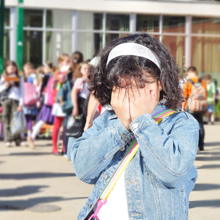The puzzle of learning disabilities
 by Jill Lauren
by Jill Lauren
To be learning disabled – meaning that a person is of average to above average intelligence with a processing deficit that makes learning challenging – is tremendously puzzling. How can one be smart, yet have trouble learning in school? This conundrum has perplexed many, including myself when I began to study various aspects of learning. In fact, I sat in a class about learning disabilities at Northwestern University for almost an entire semester without truly understanding the syndrome until a classmate explained it to me. I remember that moment clearly because I found the paradoxical nature of learning disabilities fascinating and decided to pursue a career as a special education teacher.
Kids want answers, too
When I started teaching, it was no surprise to me when my learning disabled students explained that they were completely confused by why they needed extra academic support; after all, their parents and teachers were often telling them how smart they were. Soon I realized that not only did I need to teach specific skills, but I also needed to educate my students as to what a learning disability actually was. Typically, I found that my students started questioning their academic capabilities around third grade. Prior to that time, coming to the resource room and getting stickers was reason enough to be there! By third grade, kids are more aware of who they are, in relation to their peers, and want answers.
One afternoon, I took a student named Margaret out for ice cream because though she was typically a happy child, she was becoming increasingly concerned and saddened about her academic challenges. When I asked her, “Why do you think school is hard?” she responded, “Because my parents said I have a learning disability.” I was completely surprised that she knew this term. Then I asked, “What’s a learning disability?” Her answer, “I don’t know, my parents didn’t tell me that,” helped me to fully recognize my responsibility to find a way to make the mystery of LD understandable to a third grader. I reached for the one aspect I felt could make the concept real: role models. Back in the 1980s, Tom Cruise, Cher and Bruce Jenner topped the list of success stories of people with learning disabilities. As I explained what I knew of each person, Margaret’s eyes lit up. There were other people out there like her – and they were not only successful, but also famous. My explanation completely legitimized her experience and gave her a sense of hope. She also felt proud to be just like Tom, Cher and Bruce such that she suggested to me, “There should be a book for kids like me about people with learning disabilities.” I promised Margaret I’d find that book. When I couldn’t find it, I decided to write it.
Sharing our stories is a gift to our kids
My first book, Succeeding with LD, was written in 1997, and it was dedicated to Margaret. It contained twenty-two profiles of regular folks, children and adults, with learning disabilities. I was uncomfortable profiling famous people, as I was concerned that most kids would not believe that they could really be like them. Years later, Rick Lavoie confirmed that suspicion when he shared an anecdote about a teenager who told him, “I have pimples and a big nose. What do I have in common with Tom Cruise?” Of course, when public figures share their learning challenges, it is a gift to kids. For the purposes of a book, however, I wanted students to be able to hold a book in their hands that contained at least one person with whom they could truly relate. Succeeding with LD was recently reprinted in a third edition that contains updated profiles of twenty-one of the original stories.
Last year, my publisher asked me to write a new book for younger children with learning disabilities that also profiled success stories. That’s Like Me! contains fifteen new profiles and includes a foreword by Caldecott winner Jerry Pinkney, who is also dyslexic. It is a full-colored picture book and was honored by the New York Branch of the International Dyslexia Association with the Margot Marek Award for the “most outstanding book written for adults or children with dyslexia or related learning disabilities.” I shared this award with the thirty-seven people who so courageously told their stories in both of my books in order to comfort and inspire others. I am completely honored and humbled to have been given the opportunity to bring such honest and heart-warming stories to people with learning disabilities. Many of the people in the books have become dear friends. They join me on panels to discuss various ways that people with LD can pursue their own dreams, like they did.
And where is Margaret these days? After being told by an advisor that she should not go to college, but should instead pursue a career in retail, she obtained a Masters in Social Work from Columbia University after years of grueling study. Margaret also joins me on panels, as she is now a role model herself. We often reflect on the conversation we had when Margaret was in third grade, the impact of which led to the creation of two books and have comforted so many people with learning disabilities.
Jill Lauren has a B.S. and M.A. in Learning Disabilities from Northwestern University. She has been teaching LD students of all ages for over twenty-five years. Known as an expert in the area of reading and writing, Jill has trained teachers around the country to utilize a variety of structured, multi-sensory approaches to the instruction of reading and written language. Jill has also worked with various schools to implement successful reading programs.
Note: To support the site we make money on some products, product categories and services that we talk about on this website through affiliate relationships with the merchants in question. We get a small commission on sales of those products.That in no way affects our opinions of those products and services.


